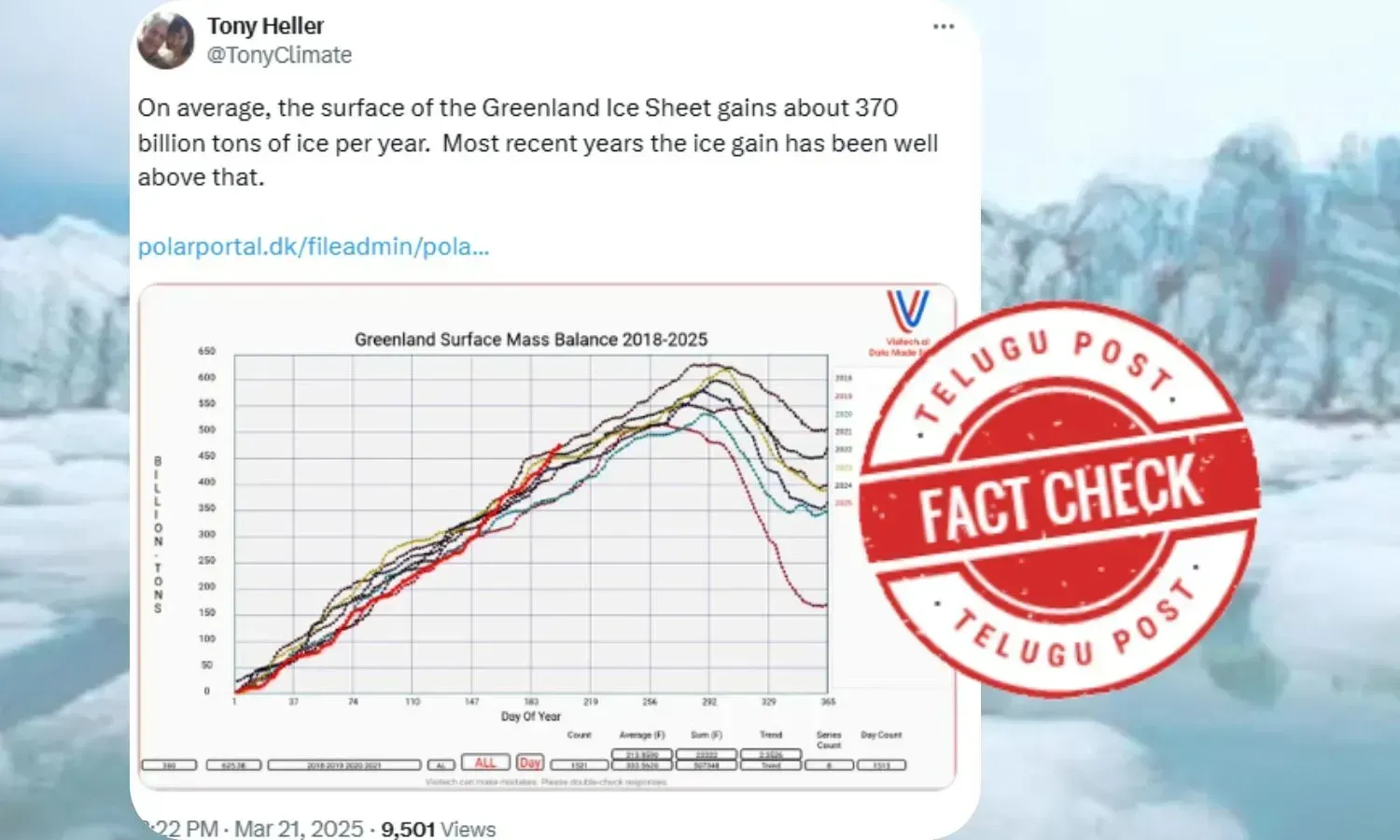Fact Check: Rare ice gain on Greenland ice sheet falsely shared as outweighing ice loss
A viral claim suggests that the Greenland Ice Sheet gains 370 billion tons of ice per year. However, investigation revealed that despite occasional short-term snowfall gains, Greenland has been experiencing net ice loss for decades due to climate change.

Claim :
Greenland ice sheet gains about 370 billion tons of ice per yearFact :
Greenland has been experiencing net ice loss for 28 consecutive years
Global warming is not only causing significant impact on the Antarctic ice sheet as well as glaciers around the world, but it is also contributing to the shrinking of Greenland’s expansive ice sheet since the 1990s.
According to a recent study done by scientists from the University of Copenhagen, glaciers in Greenland are melting five times faster than 20 years ago due to the climate change which has caused Greenland's ice sheet to lose 20 per cent more ice than previously thought.
“Almost every glacier in Greenland is retreating. And that story is true no matter where you look,” said Chad Greene, a glaciologist at the NASA Jet Propulsion Laboratory.
Meanwhile, a claim is gaining traction on X platform stating that ‘on an average, the surface of the Greenland Ice Sheet gains about 370 billion tons of ice per year. Most recent years the ice gain has been well above that.’
The viral claim link is here and the archive link here.
Here’s the screenshot of the viral post.
Fact Check:
During the investigation, the Telugupost fact check team found the claim that Greenland ice sheet net gain outweighs ice loss is misleading. Note that 80 per cent of the surface of Greenland is covered by ice.
It is a fact that climate change is affecting the glaciers worldwide. Before we dig into the details, we thought of checking the United Nations take on this.
According to an October 2024 article on UNRIC website, Greenland continues to melt due to climate change and it has shrunk for the 28th year in a row and, last year, it lost 80 gigatons of water.
Greenland is losing ice into the ocean at the rate of ‘three Olympic standard swimming pools of fresh water every second,’ UNRIC stated quoting Andreas Ahlstrøm, a glaciologist at Geological Survey of Denmark and Greenland (GEUS).
As we continued our search we came across an article on Live Science which carried a timelapse video of rapid melting ice sheet in Greenland. The video, which combines the satellite imagery from NASA and the European Space Agency, reveals 13 years of melting of the Greenland ice sheet.
The new research finds that between 2010 and 2023, Greenland lost 563 cubic miles (2,347 cubic kilometers) of ice, which is enough to fill Lake Victoria, Africa's largest lake. The research published on December 20, 2025 in the journal Geophysical Research Letters suggests between 2010 and 2022, the Greenland ice sheet has been melting at an average rate of 196 cubic kilometers per year. The edges of the ice sheet are melting more rapidly than the center, particularly at spots where glaciers flow into the sea.
Here’s the timelapse video showing the melting of the ice sheet using the combined measurements of ESA's CryoSat-2 and NASA's ICESat-2.
We found a similar animated video on the NASA Climate Change YouTube channel. The video shows rapid melting of the Greenland ice sheet between 2002 and 2023. It says Greenland shed an average of 270 billion metric tons of ice per year, adding to global sea- level rise.
These images, created from GRACE and GRACE-FO data, show changes in Greenland ice mass since 2002. Orange and red shades indicate areas that lost ice mass, while light blue shades indicate areas that gained ice mass.
Snowfall is the only way for the Greenland ice sheet to gain mass. However, the snowfall must outweigh the iceberg calving, melt at the base of the ice sheet and evaporation from the surface for the size of the ice sheet to remain constant. According to the below graph, Greenland last saw an annual net gain of ice in 1996.
Greenland's ice sheet has predominantly experienced net ice loss over recent decades. However, there have been short periods where the rate of ice loss slowed significantly, and in some instances, the ice sheet may have experienced slight gains. Hence, the claim that ‘Greenland Ice Sheet gains about 370 billion tons of ice per year’ is misleading.

